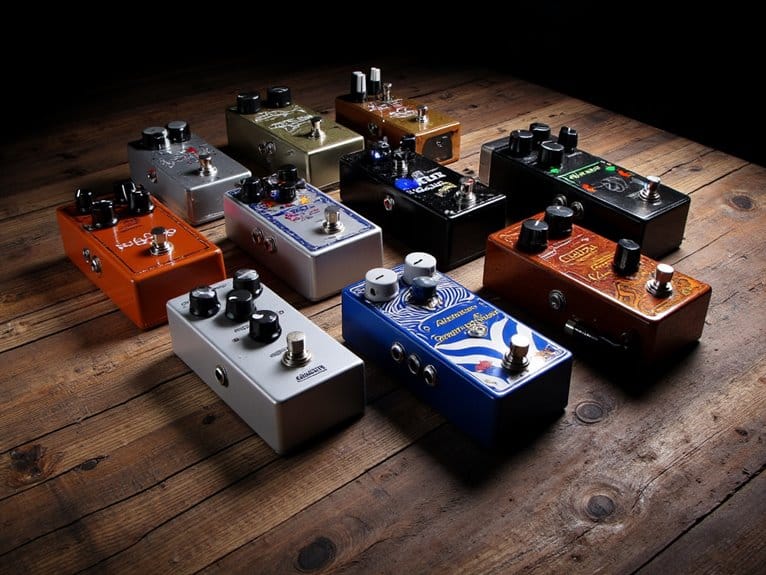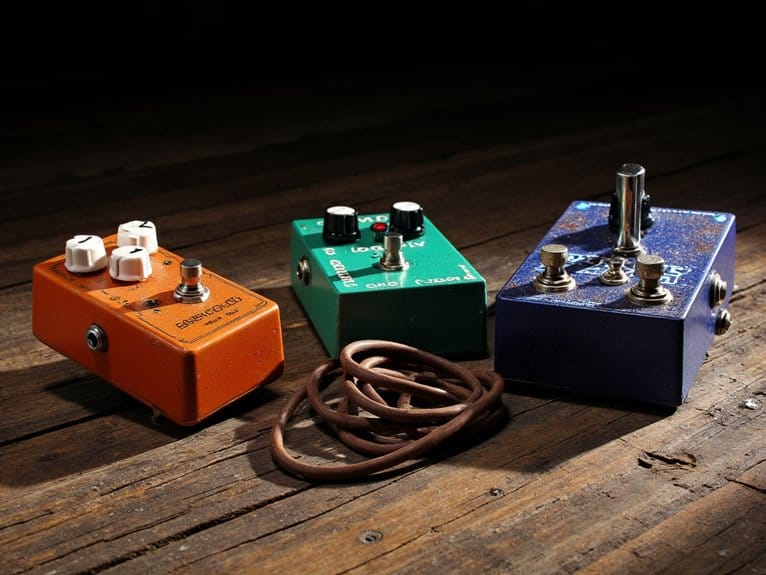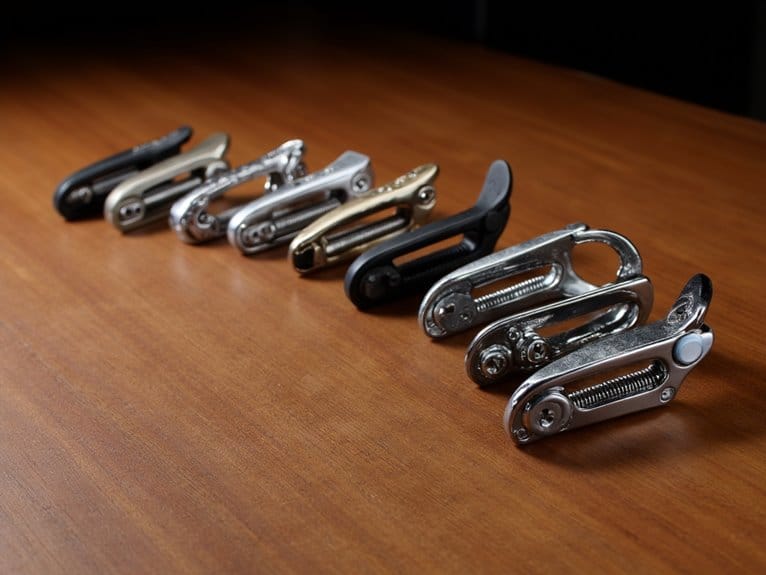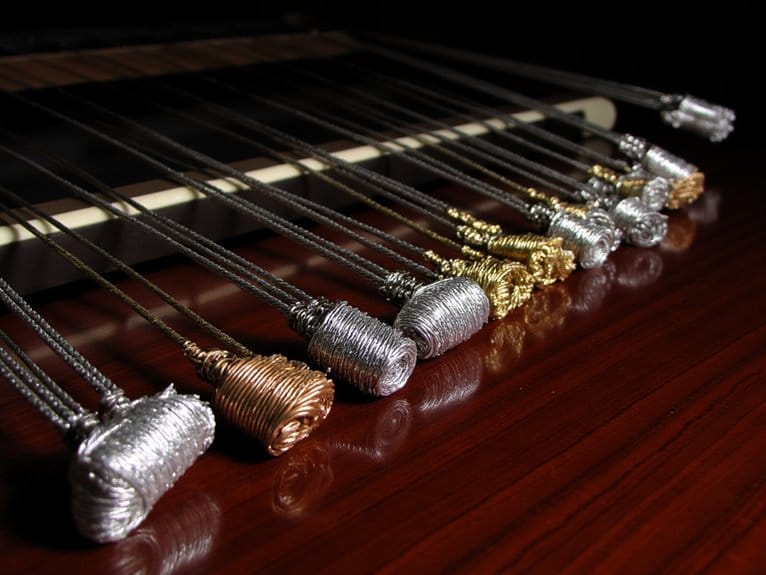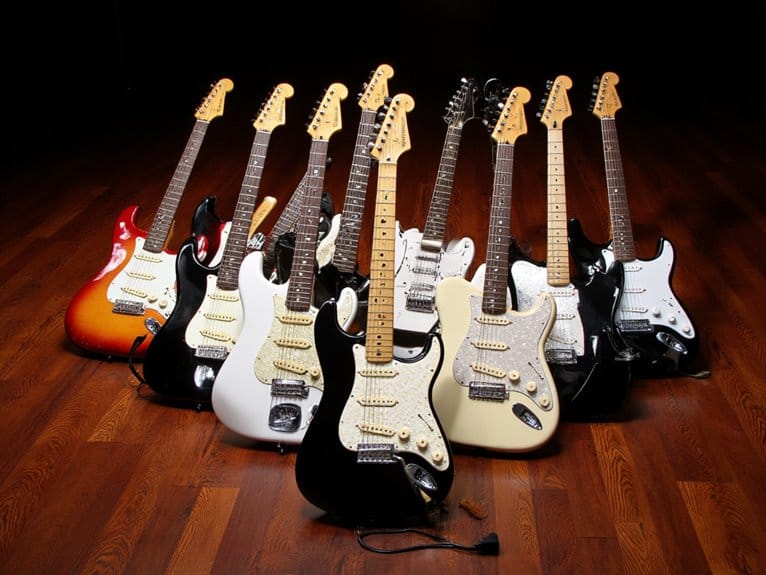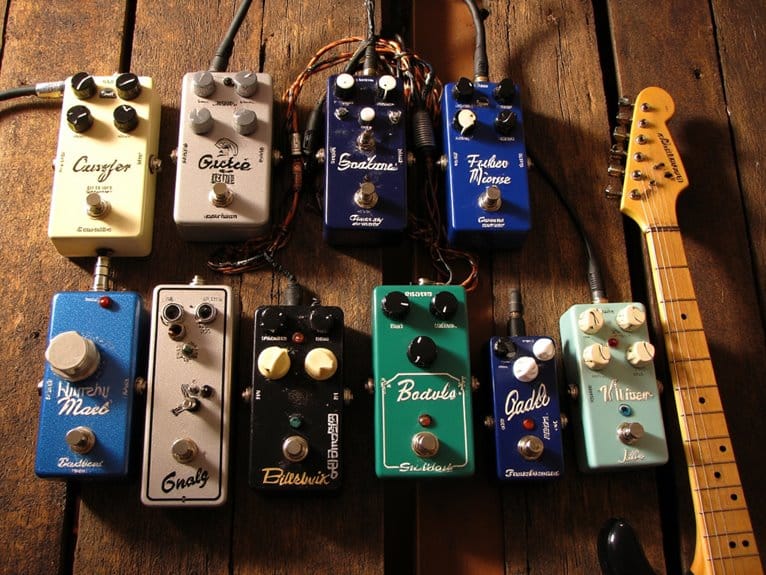10 Best Multi-Effect Pedals for Guitar Players
After testing dozens of multi-effect pedals, I’ve found the MOOER GE100 delivers exceptional value with 66 effects and an 180-second looper, while the Zoom G1X FOUR excels for beginners with its user-friendly interface and 71 built-in effects. The DS MK-300 dominates with 360+ effects for both guitar and bass, though it’s bulkier than competitors like the compact LEKATO with Bluetooth connectivity. Professional players should consider the MOOER GE150‘s 200 presets and cabinet simulations for thorough tone shaping that transforms your sound completely.
We are supported by our audience. When you purchase through links on our site, we may earn an affiliate commission, at no extra cost for you. Learn more.
Notable Insights
- MOOER GE100 offers 66 effects and 180-second looper at an affordable price, ideal for budget-conscious guitarists.
- Zoom G1X FOUR provides 71 built-in effects with user-friendly interface, perfect for beginner to intermediate players.
- DS MK-300 features over 360 effects and works for both guitar and bass, offering exceptional sonic flexibility.
- LEKATO Multi Effects includes Bluetooth connectivity for jam sessions and compact design for portable home practice.
- MOOER GE150 delivers professional-grade tones with 200 presets and extensive customization options for live performance.
MOOER GE100 Multi-Effects Guitar Pedal with 80 Presets
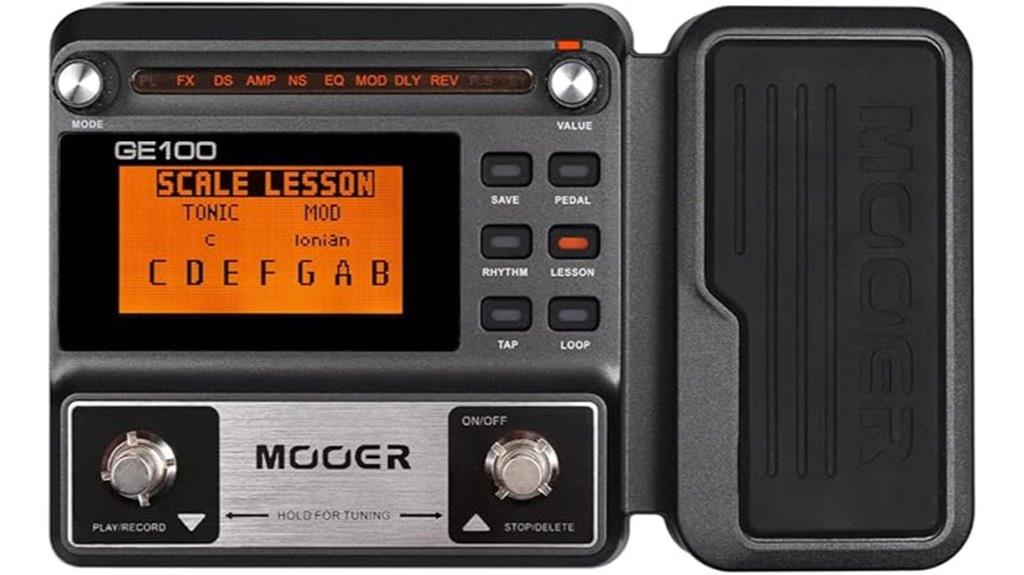
If you’re a guitarist seeking maximum versatility without breaking the bank, the MOOER GE100 Multi-Effects Guitar Pedal delivers an impressive arsenal of 66 effect types across 8 modules, plus 80 preset patches and 80 user patches that’ll satisfy most players’ creative demands. The included 180-second looper with drum machine, expression volume pedal, and tap tempo functionality make this compact 1.61-pound unit surprisingly extensive for live performance applications. While some amp models can sound slightly unnatural, the chorusing, phasing, and wah effects perform admirably for the price point, earning this pedal its #1 ranking in electric guitar floor multieffects with 4.4 out of 5 stars from over 900 customers.
Best For: Budget-conscious guitarists who want maximum versatility and extensive effects options for live performances, practice, and creative experimentation.
Pros:
- Extensive feature set with 66 effect types, 180-second looper, drum machine, and dual patch banks (80 preset + 80 user) at an affordable price point
- Compact, portable design weighing only 1.61 pounds with sturdy construction and bright display for easy stage visibility
- Flexible power options (DC adapter or 4 AA batteries) and practical live performance features like expression pedal and tap tempo
Cons:
- Some amp models sound unnatural and certain presets are considered less useful, potentially frustrating advanced users
- Steep learning curve requiring manual study for optimal use and tone customization
- Potential firmware update issues and power source compatibility problems, particularly in European markets
Zoom G1X FOUR Guitar Multi-Effects Processor with Expression Pedal
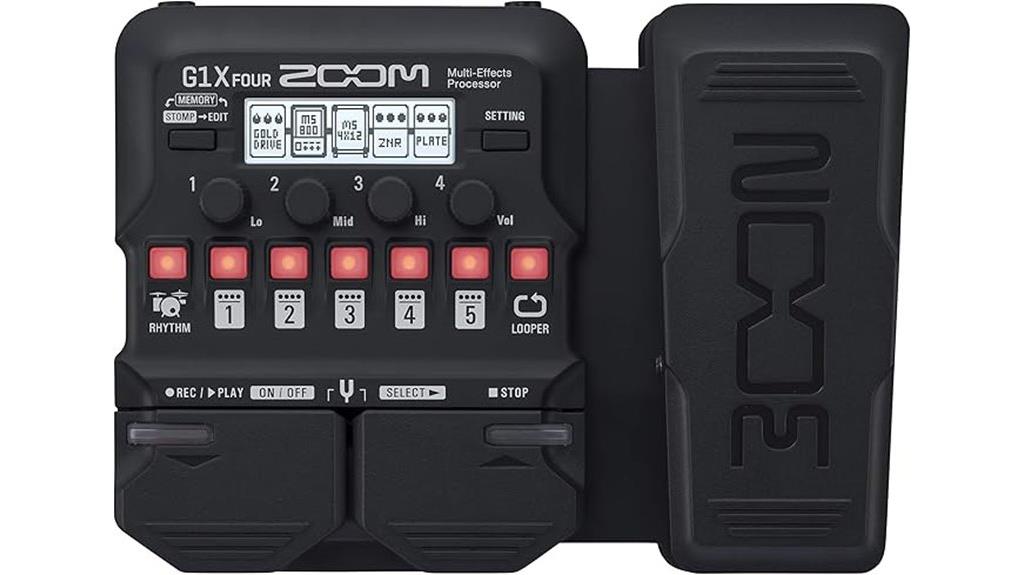
The Zoom G1X FOUR Guitar Multi-Effects Processor stands out as an exceptional choice for guitarists who need extensive effects processing without breaking the bank, offering an impressive arsenal of 71 built-in effects and 13 amp models that’ll handle everything from subtle reverbs to face-melting distortion. What really sets this unit apart is its built-in expression pedal, which gives you real-time control over parameters like wah, volume, and pitch bending without requiring additional hardware. The 30-second looper and 68 rhythm patterns provide solid practice tools, while the aux input lets you jam along with backing tracks. The free Zoom Guitar Lab software sweetens the deal considerably.
Best For: Beginner to intermediate guitarists who want a comprehensive, budget-friendly multi-effects unit with built-in expression pedal control for practice, recording, and live performance.
Pros:
- Extensive collection of 71 effects and 13 amp models provides exceptional versatility for the price point
- Built-in expression pedal eliminates the need for additional hardware while offering real-time parameter control
- Comprehensive practice features including 30-second looper, rhythm patterns, and aux input for backing tracks
Cons:
- Limited 30-second looper may be insufficient for more complex songwriting or extended practice sessions
- Build quality may not withstand heavy gigging compared to more expensive professional units
- Sound quality of amp models and effects may lack the depth and authenticity of higher-end processors
Multi-Effects Guitar Bass Pedal with 360+ Effects (DS MK-300)
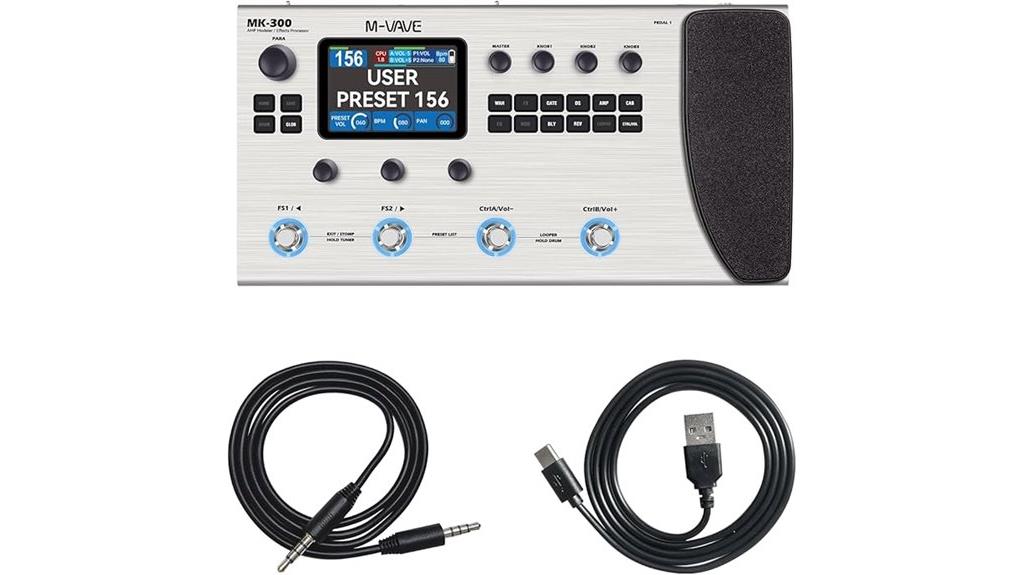
Guitar and bass players who demand extensive sonic flexibility without breaking the bank will find the DS MK-300 Multi-Effects Pedal particularly compelling, as it packs over 360 effects alongside 120 amplifier models into a surprisingly affordable package. You’ll appreciate the 11 effects blocks that enable sophisticated tone stacking, while the intuitive interface with crisp screen and LED indicators makes navigation surprisingly straightforward. The built-in 300-second stereo looper pairs nicely with 128 drum rhythms for practice sessions, and frankly, the 10-hour rechargeable battery eliminates those frustrating mid-performance power failures we’ve all experienced. With 160 preset locations and USB connectivity for computer integration, this pedal delivers professional versatility.
Best For: Guitar and bass players seeking extensive sonic flexibility and professional-grade effects versatility at an affordable price point, particularly those who value pre-programmed presets alongside customization options for both practice and performance settings.
Pros:
- Exceptional value with 360+ effects and 120 amp models, plus versatile connectivity options including USB audio interface functionality and computer integration
- Comprehensive practice features including 300-second stereo looper, 128 drum rhythms, and 10-hour rechargeable battery for uninterrupted sessions
- User-friendly design with intuitive interface, crisp screen, LED indicators, and 160 preset storage locations for easy navigation and tone management
Cons:
- Limited customer feedback available with only one review, making it difficult to assess long-term reliability and real-world performance
- Relatively heavy at 4 pounds and bulky dimensions may impact portability for musicians who prioritize compact pedalboard setups
- One-year warranty period is shorter than some competitors offer, potentially indicating less confidence in long-term durability
LEKATO Multi Effects Guitar Pedal with 9 AMP Models & Bluetooth 5.0

Budget-conscious guitarists searching for a feature-packed, portable practice companion will find the LEKATO Multi Effects Guitar Pedal delivers impressive versatility without breaking the bank, combining 9 amp models, 8 IR cabinets, and essential effects like distortion, overdrive, delay, and reverb into a compact unit that weighs less than most single-purpose pedals. You’ll appreciate the built-in rechargeable battery providing 6-8 hours of playtime, while Bluetooth 5.0 connectivity lets you jam along with backing tracks or record directly to your phone. Though some effects like reverb sound moderately cheap and the 11-millisecond latency won’t win awards, this pedal excels as a practice tool with headphone output and logical controls that become intuitive after initial familiarization.
Best For: Budget-conscious guitarists who need a portable, versatile practice pedal with multiple amp models and Bluetooth connectivity for home practice and small stage setups.
Pros:
- Excellent value with 9 amp models, 8 IR cabinets, and multiple effects in a compact, lightweight design
- Built-in rechargeable battery provides 6-8 hours of playtime with convenient Bluetooth 5.0 connectivity for backing tracks
- Perfect for practice sessions with headphone output and logical controls that become intuitive with use
Cons:
- Some effects like reverb sound cheap and the basic EQ may require additional IR fine-tuning for optimal sound
- 11-millisecond latency and audio glitches when using Bluetooth simultaneously with the tuner
- Cube Suite software installation can have compatibility issues depending on Windows version
MOOER GE150 Pro Guitar Amp Modelling Multi Effects Pedal
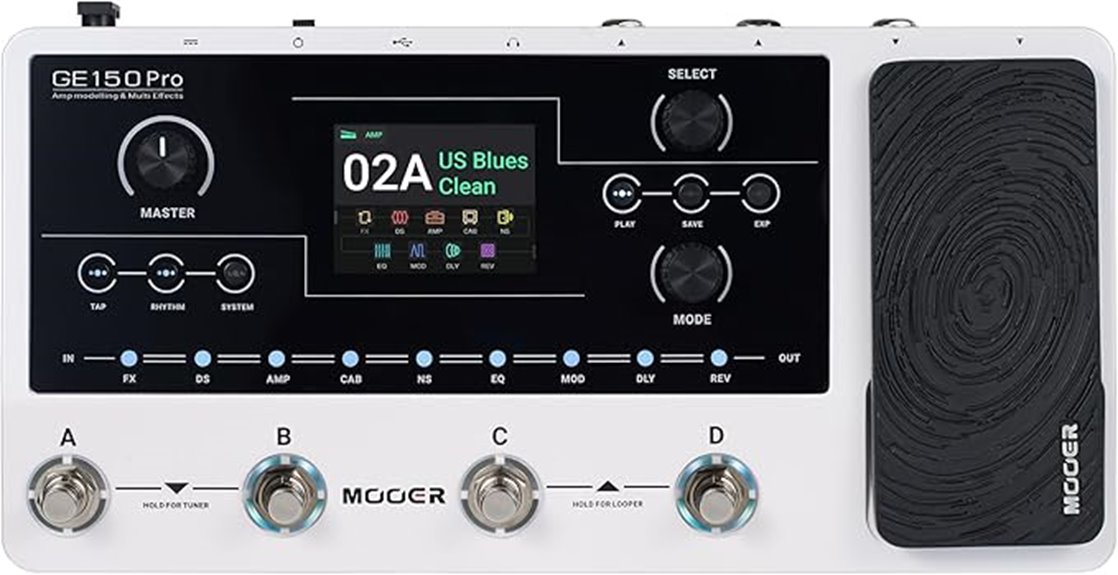
Portable versatility defines the MOOER GE150 Pro Guitar Amp Modelling Multi Effects Pedal, making it an ideal choice for guitarists who need professional-grade tones without the weight penalty of traditional rack systems or larger floor units. You’ll access 200 factory presets, including 55 classic amp preamps powered by MOOER’s MNRS modeling technology, which supports both AMP and CAB sample files for extensive tone shaping. The unit delivers 26 cabinet simulations with 20 slots each, alongside distortion, reverb, and chorus effects that you can customize extensively. Four footswitches, an expression pedal, and 80-second looper functionality enhance performance control, while the Type-C USB interface enables seamless tone editing and firmware updates for modern workflow integration.
Best For: Guitarists seeking a portable, affordable multi-effects solution with professional amp modeling, extensive preset options, and performance features like looping and drum patterns for practice sessions and live performances.
Pros:
- 200 factory presets with 55 classic amp preamps and 26 cabinet simulations provide extensive tonal variety
- Built-in 80-second looper, 40 drum rhythms, and metronome modes enhance practice and performance capabilities
- Portable design with optional 9-hour battery life (GE150 Pro Li) and Type-C USB connectivity for modern workflow integration
Cons:
- Build quality concerns reported with the expression pedal component
- LCD screen visibility issues noted by some users
- May lack the complexity and advanced features found in higher-end multi-effects units
Boss GT-1 Guitar Multi-Effects Pedal
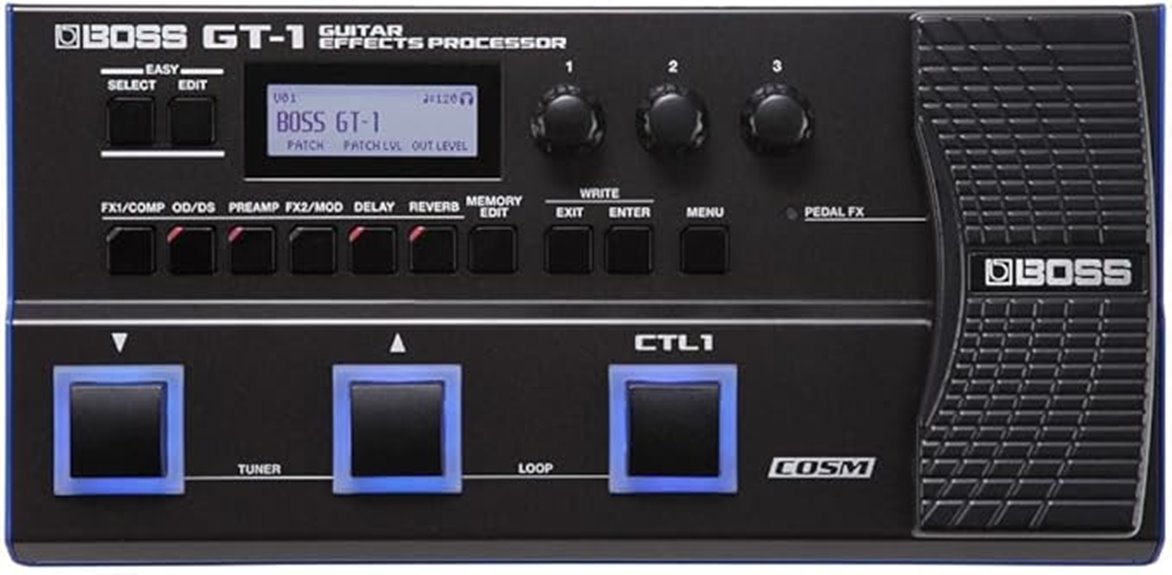
Modern guitarists seeking professional-grade versatility without the complexity of traditional multi-effects units will find the Boss GT-1 represents a compelling balance of functionality and user-friendliness, though I’ll admit the learning curve isn’t entirely eliminated. You’ll appreciate the intuitive design featuring onboard controls, expression pedal, and USB interface packed into a surprisingly portable 2.86-pound package that runs seven hours on four AA batteries. The downloadable patches from artists like Pink Floyd and Hendrix add immediate value, though you might find yourself wanting more preset options and quicker effect adjustments during live performances.
Best For: Modern guitarists who want professional-grade versatility and portability without the complexity of traditional multi-effects units, ideal for both entry-level and advanced players seeking a single pedal solution for live performances and mobile gigs.
Pros:
- Highly portable design with 7-hour battery life and intuitive controls including expression pedal and USB interface
- Excellent sound quality with downloadable artist patches from Pink Floyd, Hendrix, and other renowned musicians
- Great value for money with solid build quality and comprehensive effects including overdrive, distortion, chorus, reverb, and delay
Cons:
- Limited preset options available and lack of quick knob adjustments for real-time effect modifications during performances
- Short 32-second looper function limitation restricts extended creative applications
- Requires additional purchases like connecting cables and reliable power supply for optimal use in professional settings
MOOER PE100 Portable Multi Effects Pedal
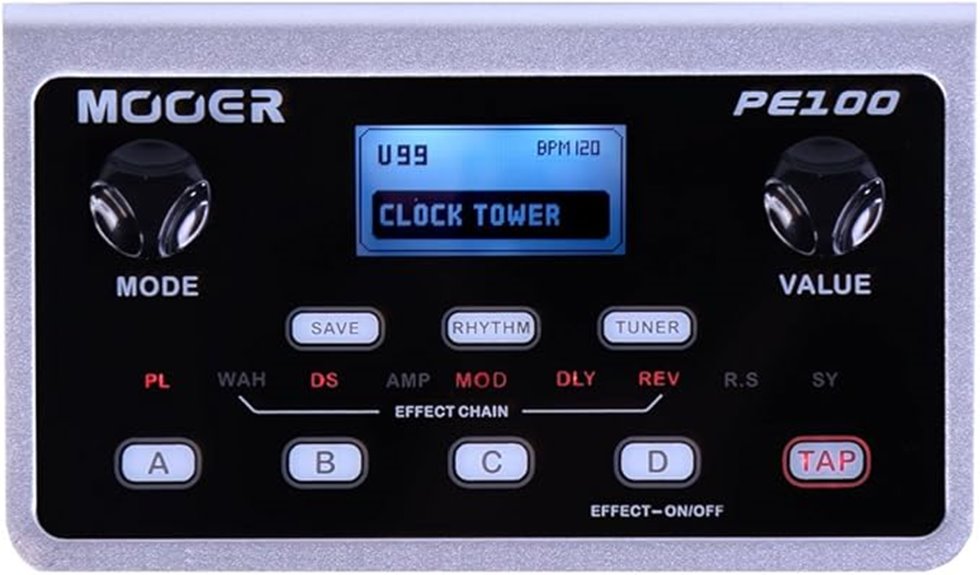
Guitar players who crave maximum versatility in a pocket-sized package will find the MOOER PE100 Portable Multi Effects Pedal surprisingly capable, weighing just 8.1 ounces while delivering 198 total presets, 39 effect types across six blocks, and extensive practice tools that include 40 drum patterns and metronomes. You’ll appreciate the touch panel operation and QUICK RECALL buttons for instant patch switching, though managing with limited footswitches requires creativity. The aluminum chassis guarantees durability, while USB connectivity allows DAW integration for recording sessions, making this compact unit punch above its weight class for both practice and performance applications.
Best For: Guitar players seeking maximum versatility in an ultra-portable package who want comprehensive effects, amp modeling, and practice tools for both silent practice sessions and live performance situations.
Pros:
- Exceptional portability at just 8.1 ounces with pocket-sized dimensions, powered by either DC adapter or AAA batteries
- Comprehensive feature set including 198 presets, 39 effect types, amp models, practice tools with drum patterns, and USB DAW integration
- Durable aluminum chassis construction with touch panel operation and instant patch access via QUICK RECALL buttons
Cons:
- Out-of-the-box sounds require tweaking and the operational interface has a learning curve that takes time to master
- Limited footswitches require creative navigation strategies for live patch switching during performances
- Mixed effects volume levels across different patches and inability to load custom amp profiles (only third-party IRs supported)
Donner Arena 2000 Guitar Multi-Effects Pedal with 278 Effects
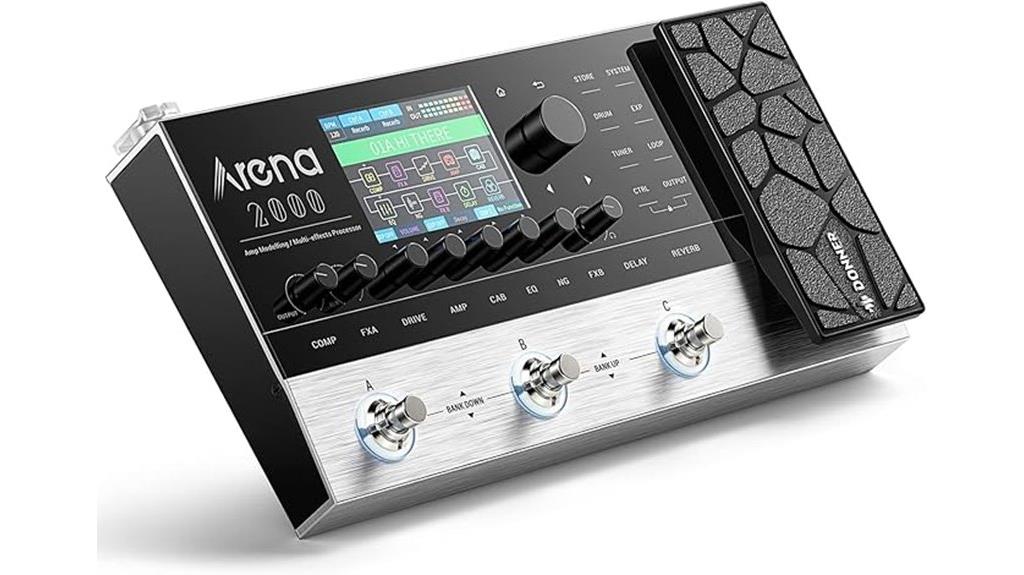
With 278 effects packed into one compact unit, the Donner Arena 2000 represents a compelling choice for guitarists who need extensive tonal versatility without breaking the bank. You’ll find 100 classic effects, 80 amp simulations, and 50 cabinet models that cover everything from pristine pop tones to crushing metal sounds, though some users report the warmer blues and rock tones don’t quite hit the mark. The 24-bit/44.1kHz processing with FAVCM technology helps reduce that digital “plastic” feel, while the 60-second looper and 40 drum rhythms make it solid for solo performances and quick songwriting.
Best For: Budget-conscious guitarists who need extensive tonal variety for multiple genres and solo performances, especially those who prioritize versatility over premium tone quality.
Pros:
- Exceptional value with 278 effects, 100 IRs, looper, and drum machine in one affordable unit
- Comprehensive connectivity options including XLR, USB, MIDI, and Bluetooth app control
- High-precision 24-bit processing reduces digital artifacts and improves overall sound quality
Cons:
- Lacks warmth and depth for certain styles, particularly blues and rock tones
- Steep learning curve for mastering the extensive controls and settings
- Poor customer service responsiveness for technical support issues
KMF-1 Guitar Multi Effects Pedal with 77 Effects

Advanced DSP technology paired with 32-bit signal processing makes the KMF-1 Guitar Multi Effects Pedal an exceptional choice for guitarists who demand professional-grade sound quality without breaking the bank. You’ll appreciate the 77 effects organized into 8 essential modules, including amplifier simulations that utilize 512-point IR sampling for remarkably accurate cabinet modeling. The upgraded 128×32 LCD screen provides real-time feedback, while the 2-in-1 expression pedal controls six assignable effects simultaneously. Battery operation delivers 2.5 hours of performance flexibility, and Flatsons backs their product with extensive 12-month warranty coverage plus responsive technical support.
Best For: Guitarists seeking professional-grade sound quality with extensive effect options for both studio recording and live performances at an affordable price point.
Pros:
- Advanced 32-bit DSP technology with 512-point IR sampling delivers exceptionally accurate amp and cabinet modeling
- Comprehensive feature set including 77 effects, 50 presets, built-in tuner, looper, and dual power options for maximum versatility
- Strong customer support with 12-month warranty, 30-day swap policy, and 24/7 technical assistance
Cons:
- Battery life of only 2.5 hours may be insufficient for longer performances without access to power outlets
- Weight of 2.55 pounds makes it heavier than some competing multi-effects pedals for guitarists prioritizing portability
- Limited to 6 assignable effects on the expression pedal, which may restrict real-time control options for complex performances
Coolmusic Multi Effects Digital Guitar Pedal (16 Effects True Bypass)
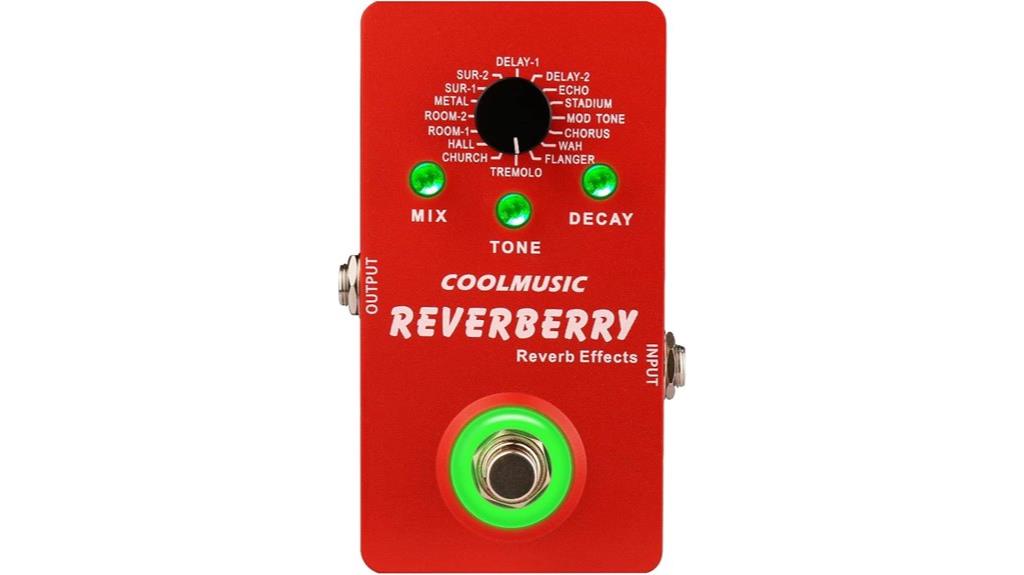
Budget-conscious guitarists who crave tonal experimentation without breaking the bank will find the Coolmusic Multi Effects Digital Guitar Pedal particularly appealing, though I’ll be upfront about its limitations from the start. This aluminum-alloy constructed unit delivers 16 effects including delays, reverbs, modulation, and distortions through true bypass circuitry, maintaining signal transparency when disengaged. While customers appreciate the variety of effects like Stadium reverb and multiple delay modes, you’ll encounter mixed results with certain effects—the auto-wah proves nearly unusable, and the small control knobs feel flimsy despite remaining functional. At 4.2 ounces and powered by 9V DC, it’s portable enough for experimentation, though reliability concerns make it better suited for casual exploration than professional performance.
Best For: Budget-conscious guitarists and beginners who want to experiment with a wide variety of effects without investing heavily in individual pedals.
Pros:
- 16 different effects in one compact, lightweight pedal (4.2 ounces) with true bypass circuitry for transparent tone
- Aluminum-alloy construction provides durability while remaining portable for different setups
- Excellent value for experimentation with standout effects like Stadium reverb and quality delay modes when properly adjusted
Cons:
- Several effects are nearly unusable, particularly the auto-wah, chorus, and standard wah functions
- Small, flimsy control knobs make precise adjustments difficult despite remaining functional
- Reliability issues including reported turn on/off switch failures make it unsuitable for professional performance
Factors to Consider When Choosing a Multi Effect Pedal
When I’m shopping for a multi-effect pedal, I’ve learned that several critical factors can make or break your investment, determining whether you’ll love your purchase or regret it within weeks. The number of effects available, sound quality standards that match your performance needs, build quality that survives gigging abuse, power source flexibility, and connectivity options that integrate seamlessly with your existing setup all require careful evaluation before you commit your hard-earned cash. I’ll walk you through each consideration systematically, sharing insights from my years of testing various units, so you can avoid the expensive mistakes I’ve made and find the pedal that truly fits your playing style and budget.
Number of Effects
One of the most significant factors I evaluate in any multi-effects pedal involves the sheer quantity and variety of effects available, which can dramatically influence your creative possibilities and sonic versatility. I’ve encountered pedals ranging from modest 16-effect units to extensive platforms offering over 360 different processing options, each catering to distinct musical needs and budgets. The diversity matters just as much as quantity – having access to multiple distortion types, modulation effects, reverbs, and delays allows you to explore various musical styles without purchasing separate stompboxes. Higher-end units typically bundle these effects with amp modeling and impulse response capabilities, creating more realistic tones, though I’ll admit the learning curve can feel overwhelming when you’re faced with hundreds of sonic possibilities.
Sound Quality Standards
The pursuit of pristine audio quality separates genuinely impressive multi-effect pedals from their mediocre counterparts, and I’ve learned that this distinction becomes immediately apparent once you plug in and start playing. Higher-end pedals utilize advanced processing technologies that deliver clarity and warmth, while budget models often produce effects that sound artificial or “cheap,” particularly with reverb and distortion. I’ve found that preset quality varies dramatically, with some pedals offering hundreds of sounds but only a handful being genuinely useful. The dynamic range and spatial accuracy provided by impulse response technology greatly enhance cabinet simulations, creating realistic tones that don’t require extensive tweaking to meet professional standards.
Build Quality Durability
Durability concerns have taught me that a multi-effect pedal’s construction quality directly impacts its longevity, especially when you’re dealing with the demanding environment of live performances and frequent transportation. I’ve learned to prioritize aluminum alloy construction over plastic housings, as metal frames provide superior impact resistance and structural integrity during those inevitable backstage fumbles. Weight distribution matters more than I initially thought—heavier pedals stay planted during aggressive stomping, while lightweight models tend to slide around your pedalboard. I always check for rubber bumpers, anti-slip surfaces, and weather-resistant seals, particularly when performing in humid venues or outdoor settings. Reading user reviews about long-term durability issues has saved me from several questionable purchases that looked impressive initially.
Power Source Options
Power considerations for multi-effect pedals have become increasingly complex as manufacturers balance portability against performance demands, forcing guitarists to weigh the trade-offs between consistent DC adapter reliability and the freedom that battery operation provides. I’ve learned that DC adapters deliver uninterrupted power during lengthy performances, eliminating mid-song battery failures that can derail your set. However, battery-powered units offer superior portability for street performances or bedroom practice sessions where outlet access isn’t guaranteed. You’ll need to assess your pedal’s power consumption carefully, as feature-rich models demand robust power sources to maintain peak performance. I always verify voltage and current compatibility before connecting any adapter, since mismatched specifications can permanently damage expensive units.
Connectivity and Compatibility
When selecting a multi-effect pedal, connectivity options determine how seamlessly the unit integrates into your existing setup, and I’ve discovered that inadequate input/output configurations can severely limit your creative possibilities. I always look for standard ¼” jack inputs for instruments and matching outputs for amplifiers, plus ⅛” headphone connections for silent practice sessions. USB connectivity has become essential in my experience, enabling tone editing, data management, and vital firmware updates that keep your pedal current. I particularly value auxiliary inputs that let me jam along with backing tracks, while MIDI support opens doors for controlling multiple devices from one interface. Third-party impulse response compatibility greatly expands your tonal palette beyond factory presets.
Budget and Value
Setting a realistic budget before you start shopping will save you from both disappointment and overspending, and I’ve learned that determining your actual needs versus wants makes this process much more straightforward. Budget-friendly options under $100 typically offer fewer effects, around 16, with limited customization compared to mid-range models around $300 that deliver wider variety and better sound quality. I’ve noticed that pedals offering 200+ effects usually fall into higher price brackets, exceeding $500, but provide exceptional versatility for diverse musical styles. Investing in slightly more expensive models often yields better durability, advanced features, and improved sound quality over time. User ratings consistently show higher customer satisfaction correlating with increased investment in pedal quality, making long-term value worth considering.
On a final note
I’ve tested countless multi-effects pedals over the years, and honestly, finding the perfect one depends entirely on your specific needs and budget. Whether you’re drawn to the MOOER GE150’s professional amp modeling, the Zoom G1X’s expression capabilities, or the DS MK-300’s massive effect library, each pedal offers distinct advantages. I’d recommend starting with your must-have features, then comparing sound quality and build construction to make your final decision.

